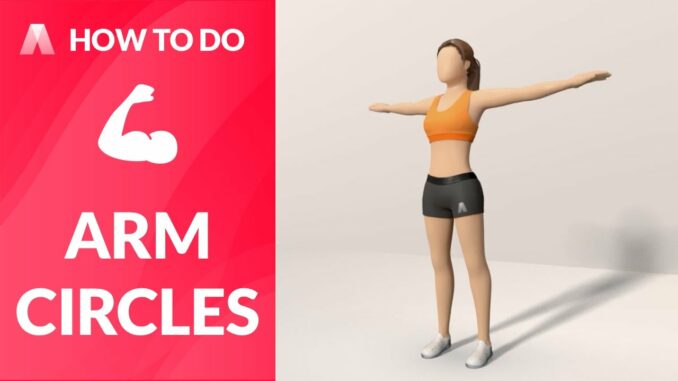
Introduction:
Amidst the vast array of exercises available in the fitness realm, the humble arm circles stand out as a deceptively simple yet highly effective movement. Originating from calisthenics and widely incorporated into warm-up routines, arm circles bring a multitude of benefits to the table. In this comprehensive exploration, we delve into the anatomy of the arms, the mechanics of arm circles, their diverse benefits, and various variations that can elevate your arm workout routine.
Section 1: Anatomy of the Arm Muscles
To understand the significance of arm circles, it’s essential to familiarize ourselves with the anatomy of the arm muscles. The arms comprise several muscle groups, including:
1.1 Biceps Brachii:
Situated on the front of the upper arm, the biceps brachii is responsible for elbow flexion and forearm supination.
1.2 Triceps Brachii:
Found on the back of the upper arm, the triceps brachii is responsible for elbow extension.
1.3 Deltoids:
The deltoid muscles, encompassing the shoulders, consist of anterior, lateral, and posterior heads, contributing to arm abduction, flexion, and extension.
Section 2: Mechanics of Arm Circles
2.1 Basic Arm Circles:
The fundamental arm circle involves extending the arms to the sides and making circular motions in a clockwise or counterclockwise direction. The movement engages the shoulder joints and activates the muscles of the arms, shoulders, and upper back.
2.2 Controlled Range of Motion:
Maintaining a controlled range of motion during arm circles is crucial to prevent strain and injury. The circles can be small and controlled for warm-ups or expanded for a more dynamic exercise, depending on fitness goals.
2.3 Dynamic Stretching:
Arm circles serve as a dynamic stretching exercise, promoting flexibility and increasing blood flow to the muscles. This, in turn, prepares the arms and shoulders for more strenuous exercises and reduces the risk of injury.
Section 3: Benefits of Arm Circles
3.1 Joint Mobility:
Performing arm circles regularly enhances joint mobility, particularly in the shoulder joints. This is especially beneficial for individuals with sedentary lifestyles or those engaging in activities that require repetitive arm movements.
3.2 Improved Circulation:
The rhythmic motion of arm circles boosts blood circulation to the arms and shoulders, delivering oxygen and nutrients to the muscles. Improved circulation aids in reducing muscle stiffness and promotes overall cardiovascular health.
3.3 Shoulder Stability:
Engaging in controlled arm circles contributes to shoulder stability by activating the muscles surrounding the shoulder joints. This, in turn, supports proper alignment and function, reducing the risk of shoulder injuries.
3.4 Enhanced Warm-up:
Arm circles are an excellent addition to warm-up routines, effectively priming the upper body for more intense exercises. The increased blood flow and flexibility contribute to optimal performance during subsequent workouts.
Section 4: Arm Circle Variations
4.1 Forward and Reverse Circles:
Performing arm circles in both forward and reverse directions targets different muscle fibers, providing a more comprehensive workout for the shoulders, arms, and upper back.
4.2 Arm Circles with Resistance:
Incorporating resistance, such as light dumbbells or resistance bands, intensifies the workout and adds an element of strength training to the arm circles.
4.3 Cross-Body Arm Circles:
Extending the arms across the body while making circular motions engages different angles of the shoulder muscles, enhancing overall shoulder mobility and flexibility.
4.4 High-Intensity Arm Circles:
Increasing the speed and intensity of arm circles transforms this seemingly simple exercise into a high-intensity workout, promoting calorie burn and cardiovascular benefits.
Section 5: Incorporating Arm Circles Into Your Routine
5.1 Warm-Up Routine:
Include arm circles as part of your warm-up routine before engaging in activities that involve the arms, such as weightlifting, sports, or upper body workouts. This helps prepare the muscles and joints for increased activity.
5.2 Active Recovery:
Arm circles can serve as an active recovery exercise between more demanding sets, allowing your muscles to stay engaged while providing a brief respite from higher-intensity movements.
5.3 Standalone Workout:
Incorporate arm circles as a standalone workout for days when you seek a lighter, yet effective, upper body workout. This is particularly useful for individuals with time constraints or those looking to diversify their exercise routine.
Conclusion:
Arm circles, often relegated to warm-up routines, emerge as a versatile and valuable addition to any fitness regimen. Beyond their simplicity lies a wealth of benefits, from enhanced joint mobility and improved circulation to increased shoulder stability. With various variations catering to different fitness levels and goals, arm circles offer a dynamic and accessible way to engage and strengthen the muscles of the arms, shoulders, and upper back. So, let your arms take center stage in your fitness journey, and revolutionize your workout with the transformative power of arm circles.